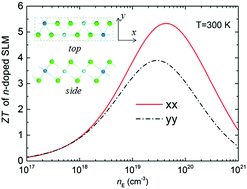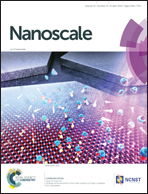Engineering of charge carriers via a two-dimensional heterostructure to enhance the thermoelectric figure of merit†
Abstract
High band degeneracy and glassy phonon transport are two remarkable features of highly efficient thermoelectric (TE) materials. The former promotes the power factor, while the latter aims to break the lower limit of lattice thermal conductivity through phonon scattering. Herein, we use the unique possibility offered by a two-dimensional superlattice-monolayer structure (SLM) to engineer the band degeneracy, charge density and phonon spectrum to maximize the thermoelectric figure of merit (ZT). First-principles calculations with Boltzmann transport equations reveal that the conduction bands of ZrSe2/HfSe2 SLM possess a highly degenerate level which gives a high n-type power factor; at the same time, the stair-like density of states yields a high Seebeck coefficient. These characteristics are absent in the individual monolayers. In addition, the SLM shows a suppressed lattice thermal conductivity along the superlattice period as phonons are effectively scattered by the interfaces. An intrinsic ZT of 5.3 (300 K) is achieved in n-type SLM, and it is 3.2 in the p-type counterpart. Compared with the theoretical predictions calculated with the same level of accuracy, these values are at least four-fold higher than those in the two parent materials, monolayer ZrSe2 and HfSe2. Our results provide a new strategy for the maximum thermoelectric performance, and clearly demonstrate the advantage of two-dimensional material heterostructures in the application of renewable energy.

- This article is part of the themed collection: Editor’s Choice: Thermoelectric nanostructures


 Please wait while we load your content...
Please wait while we load your content...